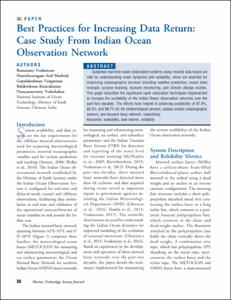Best Practices for Increasing Data Return: Case Study From Indian Ocean Observation Network

View/
Average rating
votes
Date
2019Author
Venkatesan, Ramasamy
Muthiah, Manickavasagam Arul
Vengatesan, Gopalakrishnan
Kesavakumar, Balakrishnan
Vedachalam, Narayanaswamy
Metadata
Show full item recordAbstract
Sustained real-time ocean observation systems using moored data buoys are
vital for understanding ocean dynamics and variability, which are essential for
improving oceanographic services including weather prediction, ocean state
forecast, cyclone tracking, tsunami monitoring, and climate change studies.
This paper describes the significant rapid restoration techniques implemented
to increase the availability of the Indian Ocean observation networks over the
past two decades. The efforts have helped in achieving availability of 97.9%,
82.3%, and 98.7% for the meteorological sensors, subsea surface oceanographic
sensors, and tsunami buoy network, respectively......
Journal
Marine Technology Society JournalVolume
53Issue
5Page Range
pp. 30-42Document Language
enSustainable Development Goals (SDG)
14.aMaturity Level
MatureDOI Original
https://doi.org/10.4031/MTSJ.53.5.17Citation
Venkatesan, Ramasamy, Muthiah, Manickavasagam Arul, Vengatesan, Gopalakrishnan, Kesavakumar, Balakrishnan, and Vedachalam, Narayanaswamy (2019) Best Practices for Increasing Data Return: Case Study From Indian Ocean Observation Network. Marine Technology Society Journal, 53(5), pp.30-42. DOI: https://doi.org/10.4031/MTSJ.53.5.17Collections
The following license files are associated with this item:
Except where otherwise noted, this item's license is described as Attribution-NonCommercial-NoDerivatives 4.0 International
 Repository of community practices in Ocean Research, Applications and Data/Information Management
Repository of community practices in Ocean Research, Applications and Data/Information Management
